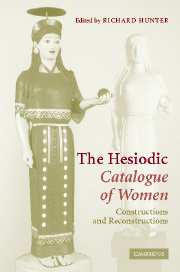Book contents
- Frontmatter
- Contents
- Notes on contributors
- Acknowledgements
- List of abbreviations
- Introduction
- 1 Ordering women in Hesiod's Catalogue
- 2 The beginning and end of the Catalogue of Women and its relation to Hesiod
- 3 Gods among men? The social and political dynamics of the Hesiodic Catalogue of Women
- 4 Heracles in the Hesiodic Catalogue of Women
- 5 Mestra at Athens: Hesiod fr. 43 and the poetics of panhellenism
- 6 A catalogue within a catalogue: Helen's suitors in the Hesiodic Catalogue of Women (frr. 196–204)
- 7 Pulp epic: the Catalogue and the Shield
- 8 The Megalai Ehoiai: a survey of the fragments
- 9 Ordered from the Catalogue: Pindar, Bacchylides, and Hesiodic genealogical poetry
- 10 The Hesiodic Catalogue and Hellenistic poetry
- 11 From genealogy to Catalogue: the Hellenistic adaptation of the Hesiodic catalogue form
- 12 The Hesiodic Catalogue of Women and Latin poetry
- 13 Or such as Ovid's Metamorphoses …
- Bibliography
- Index of passages discussed
- General index
11 - From genealogy to Catalogue: the Hellenistic adaptation of the Hesiodic catalogue form
Published online by Cambridge University Press: 22 September 2009
- Frontmatter
- Contents
- Notes on contributors
- Acknowledgements
- List of abbreviations
- Introduction
- 1 Ordering women in Hesiod's Catalogue
- 2 The beginning and end of the Catalogue of Women and its relation to Hesiod
- 3 Gods among men? The social and political dynamics of the Hesiodic Catalogue of Women
- 4 Heracles in the Hesiodic Catalogue of Women
- 5 Mestra at Athens: Hesiod fr. 43 and the poetics of panhellenism
- 6 A catalogue within a catalogue: Helen's suitors in the Hesiodic Catalogue of Women (frr. 196–204)
- 7 Pulp epic: the Catalogue and the Shield
- 8 The Megalai Ehoiai: a survey of the fragments
- 9 Ordered from the Catalogue: Pindar, Bacchylides, and Hesiodic genealogical poetry
- 10 The Hesiodic Catalogue and Hellenistic poetry
- 11 From genealogy to Catalogue: the Hellenistic adaptation of the Hesiodic catalogue form
- 12 The Hesiodic Catalogue of Women and Latin poetry
- 13 Or such as Ovid's Metamorphoses …
- Bibliography
- Index of passages discussed
- General index
Summary
Cataloguing and Hellenistic scholarly activity are frequently linked; this same cataloguing impulse is thought by some to underlie Hellenistic Kollektivgedichte – a group of poems that have in common the presentation of a number of narratives within a single work. These pieces appear to present themselves as successors to the Hesiodic Catalogue of Women, but in fact make only a limited use of its features. Their use of formulae, that is, appears to attribute the inspiration for their cataloguing of discontinuous narratives to the Hesiodic model, but there is no evidence that genealogical lists were included, or that the Hellenistic poems had the complex and varied rhythm and structure of the Catalogue of Women. It does not, however, seem wholly accurate to attribute the form and characteristics of this poetry to a scholarly interest in cataloguing alone, or to deem them ‘crudely Hesiodic’ or ‘mechanical’.
I would like to suggest that there are areas other than that of outline form in which the Catalogue appealed to Hellenistic poets, and that their use of formulae and narratives shows creative engagement with the Hesiodic poem. The altered cultural situations of the archaic and Hellenistic periods may account for some of the major differences, and in addition some of our knowledge of Kollektivgedichte is flawed through the excessive reliance that has been placed on the deliberately misleading information contained in Hermesianax's catalogue of poets.
- Type
- Chapter
- Information
- The Hesiodic Catalogue of WomenConstructions and Reconstructions, pp. 266 - 286Publisher: Cambridge University PressPrint publication year: 2005
- 33
- Cited by

